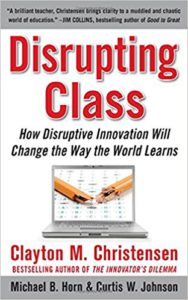Between 2008 and 2011, I wrote several brief reviews of books which appeared on the Education Review web site. Since then, the editors ceased publication of that type of review and removed the previously published brief reviews from the site. I am making the original drafts of my reviews available here.
Brief Review of Christensen, C. M., Horn, M. B., & Johnson, C. W. (2008). Disrupting class: how disruptive inovation will change the way the world learns. New York: McGraw-Hill.
By Dr. Gary L. Ackerman, October 2008
 In recent decades, many organizations and individuals have proposed reforms to education. The unending sequence of proposals is evidence the improvements promised by advocates for reforms are not realized. Christensen, Horn, and Johnson appear to be proposing another educational reform that will follow the familiar pattern, but their book differs from those to which educators have become accustomed.
In recent decades, many organizations and individuals have proposed reforms to education. The unending sequence of proposals is evidence the improvements promised by advocates for reforms are not realized. Christensen, Horn, and Johnson appear to be proposing another educational reform that will follow the familiar pattern, but their book differs from those to which educators have become accustomed.
Few will dispute the author’s observations made to begin the book. Historical and cultural traditions that inhibit educational change and the changing understandings of intelligence and learning will be recognized by most educators. The authors proceed to the reasonable conclusion that schools in the twenty-first century will differ significantly from schools in the twentieth century, and the reform of education depends on the systematic adoption of innovative practices.
Many educators will find the subsequent review of research focusing on the spread of innovative practices in other businesses and industries informative; this treatment of innovation is the book’s unique contribution to the field of educational reform. The authors describe how forces within a well-established field of endeavor (of which eduction is an excellent example) prevent reforms, even those that will lead to necessary improvements in the field. In addition to reviewing trends that have been observed in other fields, the authors review how innovative practices can become established and then spread throughout a field of endeavor.
The authors include several chapters to propose innovative educational practices they believe will be central to twenty-first century education. Whereas Christensen, Horn, and Johnson argue convincingly for the need to reform education in innovative ways and they provide valuable lessons for those who seek to understand how to innovate in education, their proposed educational practices are not necessarily innovative. Experienced educators will recognize the practices because they have been included in the series of reforms over the past decades.
The proposed practices include individualized courses delivered via computer networks, renewed attention to early education, renewed focus on research, and charter schools. Whereas these practices are likely to be a part of twenty-first century education, the authors do not describe how each is or can be innovative. Delivering courses designed for twentieth century goals using computer networks may be an innovative way to deliver instruction, but the results may not be the reform we seek for the twenty-first century. Similar criticisms can be leveled against the cases made for the other proposed practices; the details of how the innovative practices must differ from previous efforts to reform education through those practices appear missing.
Christensen, Horn, and Johnson establish the need for innovative practices in education. They share insights to help educators understand how innovation has occurred in other field of endeavor. They provide a structure that will help educators develop and share their innovative practices. They do not, however, provide clear guidance on differentiating innovative practices from practices that are not. Read this book to understand innovation and how it is disseminated. Plan carefully to ensure the practices you disseminate really are innovative and the promised improvements are realized and sustained.